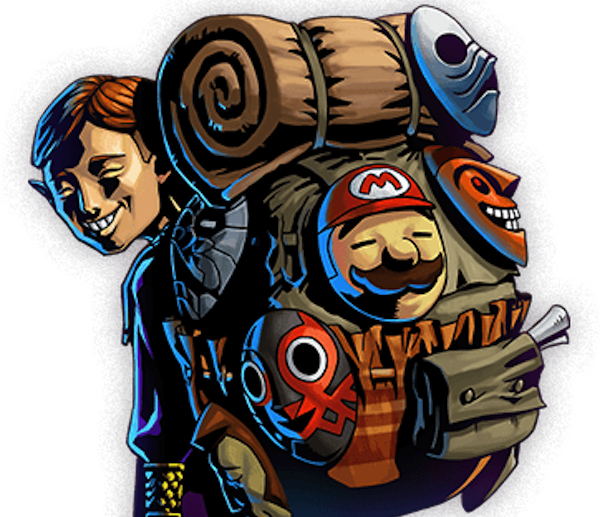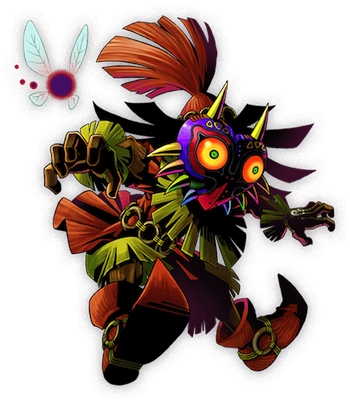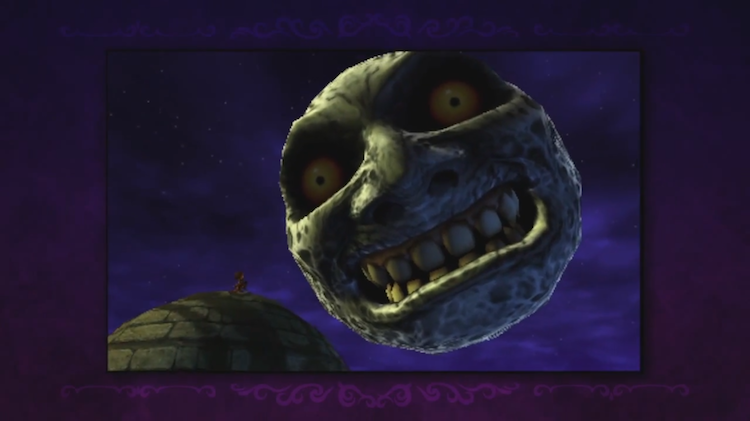Video Game Review: “The Legend of Zelda: Majora’s Mask 3D” — Worthy of a Cult
The Legend of Zelda: Majora’s Mask is the video game version of Groundhog’s Day — you’re Bill Murray, and it’s brilliant.

The Mask Salesman in “Majora’s Mask.”
By Anthony Montuori
During its 29 year, 16-game history, The Legend of Zelda series has never failed. From its groundbreaking introduction in 1986 to 2013’s A link Between Worlds, the Zelda games have proved to comprise one of gaming’s most competent series, often shifting the artistic landscape while attracting new generations of players who inevitably declare that the title they started with is the best in the franchise. It’s a series so universally praised that the thought of one of its entries being considered a cult classic is odd, even bizarre. But The Legend of Zelda: Majora’s Mask fits that marginalized category — placing it high in the pantheon of Zelda games inevitably invites an argument. High praise and glowing review scores at the time of the game’s release in 2000 did not settle the matter. So its re-release this year on the Nintendo 3DS offers a perfect opportunity to assert the claim that Majora’s Mask is not only a great Zelda game, but the best the series has to offer.
Introduced in 1986, no other video game before The Legend of Zelda gave the player quite as much freedom to explore an open world. It was the first home console game with a battery in the cartridge so that progress could be saved. A Link to The Past, released in 1991, was groundbreaking because it added a ‘secret’ world that had been built on top of the existing one. It also fleshed out the storyline for which the series would become celebrated. In 1998, five years after a new entry had been introduced to the series, Ocarina of Time was met with universal praise (it still holds the top spot on Metacritic’s ratings chart after seventeen years). Arguably the most groundbreaking title in the series, the game is responsible for introducing a lock-on targeting mechanic that has become ubiquitous in gaming because it solved the issues raised by navigating an emergent three-dimensional space. In 2002 The Wind Waker, second to Majora’s Mask in cult status, was released. It was greeted with scorn because the dramatic stylistic shift in its graphics took the series into a more cartoon-like direction. But the game eventually won praise for its risk taking — it decisively chose style over gritty reality. Finally, in 2011, Skyward Sword realized the promise of the Wii remote: it introduced a one-to-one sword swinging mechanic aimed at immersing the player in the action.

Skull Kid in “Majora’s Mask” — pure anarchy.
Despite its history of innovation, the narrative approach of the Zelda series is remarkably conservative. Each game re-imagines the same fable: You play as the hero, Link, who encounters Princess Zelda. The pair venture through a rich variety of dungeons, towns, and alternate dimensions to defeat Ganon (or Ganondorf) and end his attempts to control the land of Hyrule. That’s it — enough to scratch an adventurer’s itch, but nothing that would give J.R.R. Tolkien much to worry about. Just about every game follows this narrative arc; the titles are mainly differentiated by stylistic or geographical shifts. New games often time hop, taking place centuries apart: the cast of characters are the ancestors or reincarnations of previous versions of Link, Zelda, and Ganon. This simplicity has proved to be a virtue, but it is understandable that veterans of the series are attracted to the titles that deviate from the formula – to games like Link’s Awakening, the Oracles pair, Spirit Tracks and of course, Majora’s Mask.
Originally released in 2000 for the Nintendo 64, just two short years after the landmark Ocarina of Time, Majora’s Mask had the unenviable task of living up to its predecessor on a system that was about to be pushed aside for better hardware. It had the odds stacked against it, like any breakout band’s sophomore album. It will be dismissed if it is either too similar or too different. Majora’s Mask managed to be both at once. Under a tight development schedule, director Eiji Aonuma had no other option but to make a follow-up that recycled almost all of the assets used to build the previous game. Having just told the classic Zelda tale he could not repeat himself.
After Link saves Hyrule, he sets out to find Navi, his fairy companion, who had left him at the end of Ocarina of Time. He looks for her in the Lost Woods and comes across the Skull Kid, a minor but familiar character who is possessed by an evil mask that turns its victim into more of a Joker than a Darth Vader. The Skull Kid steals Link’s ocarina and horse, Epona, and rides off into the woods with our hero in tow. The Lost Woods are as advertised and Link ends up in Termina – a seemingly impossible geographic location populated by people that look exactly like the denizens of Hyrule, but with a terrifying anthropomorphized moon glairing down on the city, ready to fall. As Link, transformed by the Skull Kid into a small tree-like creature, enters the central hub, Clock Town, he is met by a mask salesman, who begs him to retrieve the stolen mask in just three short days (an impossible task). The player is then given the reins and tossed into a new world with only about an hour in real-time to right the Skull Kid’s wrongs, restore Link to his natural form, and save Termina from the falling moon.

Link in “Majora’s Mask” — a Sisyphean figure.
This is the flight or fight moment for anyone sitting down with the game for the first time: “You want me to do what, in an hour?” If you decide to keep playing, the three day time limit is over in the blink of an eye and you’re already at the end of the game. Of course, you’ve accomplished little of what’s been asked of you. Not giving up, you attack the Skull kid, get your ocarina back, and learn the Song of Time; suddenly, the first day dawns. Your mind is soup.
Majora’s Mask is the video game version of Groundhog’s Day — you’re Bill Murray, and it’s brilliant. Armed with the ability to reset the three day cycle as often as you want, you’re given the chance to comprehensibly probe the lives of the people and creatures that populate Termina. No other video game has given a player this intimate a relationship with its supporting cast of characters. Thankfully, certain items and upgrades are pulled back in time to count towards your overall progress. But consumable items and side-quest progress are reset; the aim is that eventually you will gather everything you need to properly confront the Skull Kid. The set-up might sound grueling, but in practice it somehow never becomes repetitive. Instead, the imaginative scope of the interconnected world becomes progressively more engaging as you gain access to new regions and characters.
Perhaps more remarkable than the gameplay mechanic, however, is Majora’s Mask‘s thematic weight; it is about the inevitability of death and the various ways people confront that truth. Case in point: the reaction to the moon, with its menacing stare, as it slowly inches closer and closer to the city. Everyone in Termina treats this fact of life differently; some are terrified, some flee, others pretend to ignore it, and a few seem to be genuinely oblivious. There are a rare handful of Termina residents who welcome the moon, staring right back into its bright orange eyes, shouting threats. The prescribed path Link takes through the game appears to parallel the Kübler-Ross model of grief, subtly putting the player through the five-stage process of mourning. Link travels to five locations during the game: In clock town he encounters denial of the moon’s inevitable collapse; in the swamp he confronts an angry, inconsolable monarch; a journey to the mountains find him helping a dead warrior who bargains with Link to have his life restored; in the ocean he consoles a depressed mother who has lost her children, and finally, in the barren Ikana Canyon (a literal land of the dead) he finds acceptance when he helps various deceased characters. He even encounters the Garo, a tribe of warriors who commit suicide when they are defeated.

The Moon of Doom in “Majora’s Mask.”
Some theorize that Link is stuck in a personal purgatory throughout the game, but I see Majora’s Mask as an uncharacteristically mature way for the video game medium to confront mortality. Given the Zelda games’ dependence on ‘innocent’ subject matter, the choice to deal with such a challenging topic in a beloved series comes off as somewhat courageous. What we get here is a strange, very dark world that reveals its macabre intentions to those who are willing to look for them. The typical villain in the Zelda games never becomes a concrete threat. In contrast, the Skull Kid represents a kind of entropy, or chaos. You never really see the figure in the game, but the fruits of his devilish mischief can be found everywhere. His anarchy and the indifference of the moon amp up the urgency of Link’s actions: the undoing of any good deeds after a reset to the first day positions him as more of a Sisyphean figure than an invincible hero.
Thankfully, the updated 3DS version does nothing to alter the original experience. It ups the visual fidelity in simple ways with texture and model improvements; it also keeps the frame rate consistent and the game more stable (the original version was prone to lock up randomly and performed poorly on the N64). These subtle changes are welcome, but it’s the expansion of the player notebook, where you can keep track of the lives of the characters, that really improves the experience. The notebook was a bit simple before — now it is a crucial tool in keeping track of the intricacy of the game. Returning players will notice that the update fixes the old, admittedly broken save system, adds a couple unnecessary fishing holes to waste time in, and with varying levels of success tweaks the boss fights. The bottom line is that the new version of this landmark title is far more satisfying than the original version. If you’ve never played Majora’s Mask before, or want to experience it again, this is the place to go. If you can get through the first three days, I promise you will have an experience unlike any other in gaming’s history.
Anthony Montuori is a practicing visual artist that uses video games as an unlikely medium to discuss the existential void. Originally from upstate New York, he now lives and works just outside of Boston and makes a living as a professional freelance art handler specializing in technology based artworks.
Tagged: A link Between Worlds, Anthony Montuori, Link’s Awakening, The Legend of Zelda
